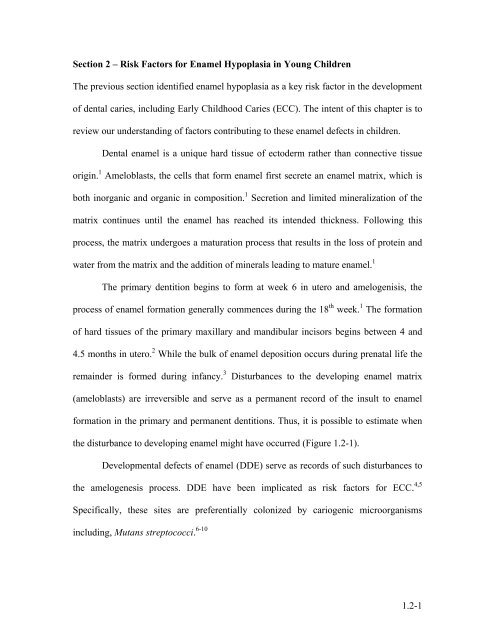Influence of Maternal Prenatal Vitamin D Status on Infant Oral Health
Influence of Maternal Prenatal Vitamin D Status on Infant Oral Health
Influence of Maternal Prenatal Vitamin D Status on Infant Oral Health
You also want an ePaper? Increase the reach of your titles
YUMPU automatically turns print PDFs into web optimized ePapers that Google loves.
Secti<strong>on</strong> 2 – Risk Factors for Enamel Hypoplasia in Young Children<br />
The previous secti<strong>on</strong> identified enamel hypoplasia as a key risk factor in the development<br />
<str<strong>on</strong>g>of</str<strong>on</strong>g> dental caries, including Early Childhood Caries (ECC). The intent <str<strong>on</strong>g>of</str<strong>on</strong>g> this chapter is to<br />
review our understanding <str<strong>on</strong>g>of</str<strong>on</strong>g> factors c<strong>on</strong>tributing to these enamel defects in children.<br />
Dental enamel is a unique hard tissue <str<strong>on</strong>g>of</str<strong>on</strong>g> ectoderm rather than c<strong>on</strong>nective tissue<br />
origin. 1 Ameloblasts, the cells that form enamel first secrete an enamel matrix, which is<br />
both inorganic and organic in compositi<strong>on</strong>. 1 Secreti<strong>on</strong> and limited mineralizati<strong>on</strong> <str<strong>on</strong>g>of</str<strong>on</strong>g> the<br />
matrix c<strong>on</strong>tinues until the enamel has reached its intended thickness. Following this<br />
process, the matrix undergoes a maturati<strong>on</strong> process that results in the loss <str<strong>on</strong>g>of</str<strong>on</strong>g> protein and<br />
water from the matrix and the additi<strong>on</strong> <str<strong>on</strong>g>of</str<strong>on</strong>g> minerals leading to mature enamel. 1<br />
The primary dentiti<strong>on</strong> begins to form at week 6 in utero and amelogenisis, the<br />
process <str<strong>on</strong>g>of</str<strong>on</strong>g> enamel formati<strong>on</strong> generally commences during the 18 th week. 1 The formati<strong>on</strong><br />
<str<strong>on</strong>g>of</str<strong>on</strong>g> hard tissues <str<strong>on</strong>g>of</str<strong>on</strong>g> the primary maxillary and mandibular incisors begins between 4 and<br />
4.5 m<strong>on</strong>ths in utero. 2 While the bulk <str<strong>on</strong>g>of</str<strong>on</strong>g> enamel depositi<strong>on</strong> occurs during prenatal life the<br />
remainder is formed during infancy. 3<br />
Disturbances to the developing enamel matrix<br />
(ameloblasts) are irreversible and serve as a permanent record <str<strong>on</strong>g>of</str<strong>on</strong>g> the insult to enamel<br />
formati<strong>on</strong> in the primary and permanent dentiti<strong>on</strong>s. Thus, it is possible to estimate when<br />
the disturbance to developing enamel might have occurred (Figure 1.2-1).<br />
Developmental defects <str<strong>on</strong>g>of</str<strong>on</strong>g> enamel (DDE) serve as records <str<strong>on</strong>g>of</str<strong>on</strong>g> such disturbances to<br />
the amelogenesis process. DDE have been implicated as risk factors for ECC. 4,5<br />
Specifically, these sites are preferentially col<strong>on</strong>ized by cariogenic microorganisms<br />
including, Mutans streptococci. 6-10 1.2-1







![an unusual bacterial isolate from in partial fulf]lment for the ... - MSpace](https://img.yumpu.com/21942008/1/190x245/an-unusual-bacterial-isolate-from-in-partial-fulflment-for-the-mspace.jpg?quality=85)





![in partial fulfil]ment of the - MSpace - University of Manitoba](https://img.yumpu.com/21941988/1/190x245/in-partial-fulfilment-of-the-mspace-university-of-manitoba.jpg?quality=85)


